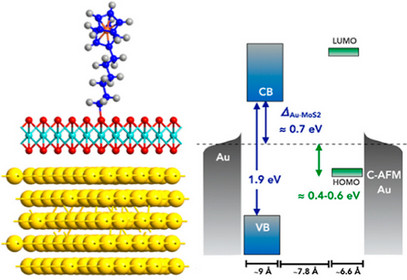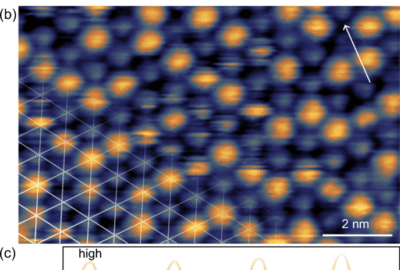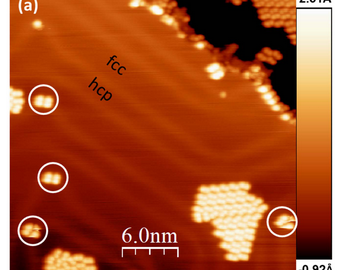publications, Réseau
Electronic Properties of Electroactive Ferrocenyl-Functionalized MoS2
The attachment of redox-active molecules to transition metal dichalcogenides, such as MoS2, constitutes a promising approach for designing electrochemically switchable devices through the control of the material’s charge/spin transport properties by the redox state of the grafted molecule and thus the applied electrical potential. In this work, defective plasma-treated MoS2 is functionalized by a ferrocene derivative and thoroughly investigated by various characterization techniques, such as Raman, photoluminescence, and X-ray photoelectron spectroscopies; atomic force microscopy (AFM); and electrochemistry. Furthermore, in-plane and out-of-plane conductive AFM measurements (I–V and first derivative ∂I/∂V–V curves) are measured to investigate the effect of the chemical functionalization of MoS2 on the electron transport properties. While the conduction and valence bands are determined at +0.7 and −1.2 eV with respect to the electrode’s Fermi energy for pristine MoS2, additional states in an energy range of ≈0.45 eV below the MoS2 conduction band are measured after plasma treatment, attributed to S-vacancies. For ferrocene-functionalized MoS2, the S-vacancy states are no longer observed, resulting from the defect healing. However, two bumps at lower voltages in the ∂I/∂V–V indicate a contribution to electron transport through ferrocene’s highest occupied molecular orbital, which is located in the MoS2 band gap at ≈0.4/0.6 eV below the Fermi energy. These results are in good agreement with theoretical density functional theory calculations and UV photoelectron spectroscopy measurements.
Trung Nghia Nguyên Lê, Kirill Kondratenko, Imane Arbouch, Alain Moréac, Jean-Christophe Le Breton, Colin van Dyck, Jérôme Cornil, Dominique Vuillaume, and Bruno Fabre*, J. Phys. Chem. C 2024, 128, 18, 7706–7722
Comments are closed






